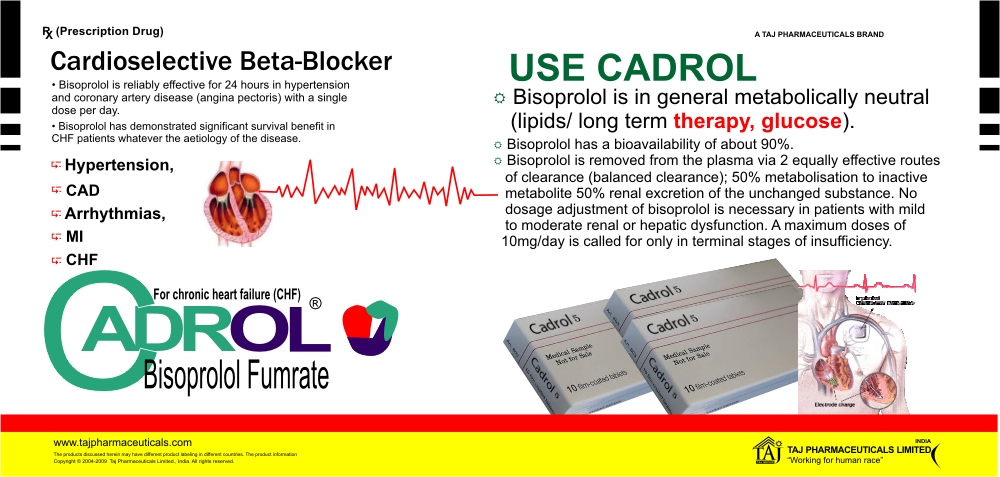|
|
Each Cadrol 2.5 mg/6.25 mg tablet contains:
Bisoprolol fumarate...................................................2.5
mg
Each Cadrol 5 mg/6.25 mg tablet contains:
Bisoprolol fumarate...................................................5
mg
Each Cadrol 10 mg/6.25 mg tablet contains:
Bisoprolol fumarate..................................................10
mg
Inactive ingredients include Colloidal Silicon Dioxide,
Corn Starch, Dibasic Calcium Phosphate, Hypromellose, Magnesium
Stearate, Microcrystalline Cellulose, Polyethylene Glycol,
Polysorbate 80, and Titanium Dioxide. The 5 mg/6.25 mg tablet also
contains Red and Yellow Iron Oxide. The 2.5 mg/6.25 mg tablet also
contains Crospovidone, Pregelatinized Starch, and Yellow Iron
Oxide.
INDICATIONS
Cadrol (bisoprolol fumarate and hydrochlorothiazide) is indicated
in the management of hypertension. It combines two
antihypertensive agents in a once-daily dosage: a synthetic
beta1-selective (cardioselective) adrenoceptor blocking agent (bisoprolol
fumarate) and a benzothiadiazine diuretic (hydrochlorothiazide).
USES
This combination medication is used to treat high blood pressure
(hypertension). Lowering high blood pressure helps prevent
strokes, heart attacks, and kidney problems.

This product contains two medications. Bisoprolol is a beta
blocker that works by blocking the effect of certain natural
chemicals (e.g., epinephrine) on the heart and blood vessels. This
slows your heartbeat, lowers blood pressure, and reduces strain on
the heart. Hydrochlorothiazide is a "water pill" (diuretic) that
works by increasing the amount of urine that you make. This causes
your body to get rid of extra salt and water, which probably helps
to relax the blood vessels so that blood can flow more easily.
These two drugs are used together when one medication is not
controlling your blood pressure. Using these two drugs together
can also reduce the amount of each drug you must take, thereby
decreasing the chances of side effects.
DOSAGE AND ADMINISTRATION
Bisoprolol is an effective treatment of hypertension in once-daily
doses of 2.5 to 40 mg, while hydrochlorothiazide is effective in
doses of 12.5 to 50 mg. In clinical trials of bisoprolol/hydrochlorothiazide
combination therapy using bisoprolol doses of 2.5 to 20 mg and
hydrochlorothiazide doses of 6.25 to 25 mg, the antihypertensive
effects increased with increasing doses of either component.
WARNINGS
Cardiac Failure: In general, beta-blocking agents should be
avoided in patients with overt congestive failure. However, in
some patients with compensated cardiac failure, it may be
necessary to utilize these agents. In such situations, they must
be used cautiously.
PRECAUTIONS
General
Electrolyte and Fluid Balance Status: Although the probability of
developing hypokalemia is reduced with Cadrol because of the very
low dose of HCTZ employed, periodic determination of serum
electrolytes should be performed, and patients should be observed
for signs of fluid or electrolyte disturbances, ie, hyponatremia,
hypochloremic alkalosis, hypokalemia, and hypomagnesemia.
Thiazides have been shown to increase the urinary excretion of
magnesium; this may result in hypomagnesemia.
Parathyroid Disease
Calcium excretion is decreased by thiazides, and pathologic
changes in the parathyroid glands, with hypercalcemia and
hypophosphatemia, have been observed in a few patients on
prolonged thiazide therapy.
CONTRAINDICATIONS
Cadrol is contraindicated in patients in cardiogenic shock, overt
cardiac failure (see WARNINGS), second or third degree AV block,
marked sinus bradycardia, anuria, and hypersensitivity to either
component of this product or to other sulfonamide-derived drugs.
Presentation
Cadrol
Tablets
Blister of 10 Tablets
|
|





